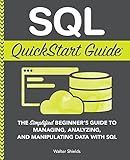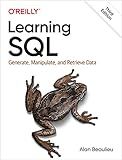Best SQL Books to Buy in January 2026

SQL QuickStart Guide: The Simplified Beginner's Guide to Managing, Analyzing, and Manipulating Data With SQL (Coding & Programming - QuickStart Guides)



Practical SQL, 2nd Edition: A Beginner's Guide to Storytelling with Data



SQL Programming QuickStudy Laminated Reference Guide



SQL for Data Analysis: Advanced Techniques for Transforming Data into Insights



SQL Pocket Guide: A Guide to SQL Usage



Learning SQL: Generate, Manipulate, and Retrieve Data



SQL Queries for Mere Mortals: A Hands-On Guide to Data Manipulation in SQL



SQL Cookbook: Query Solutions and Techniques for All SQL Users



SQL All-in-One For Dummies (For Dummies (Computer/Tech))



SQL in 10 Minutes a Day, Sams Teach Yourself


Subqueries in MySQL are queries that are nested within other queries. They can be used to retrieve data from one table and use it in another table, or to filter data based on specific constraints.
To use subqueries in MySQL, you need to enclose the subquery within parentheses and use it in the WHERE clause, SELECT clause, or FROM clause of the main query. The result of the subquery can then be used as a condition or value in the main query.
For example, you can use a subquery to find all employees who have a salary greater than the average salary of all employees in the company. This can be achieved by writing a subquery that calculates the average salary first, and then using that result in the main query to filter the employees.
Subqueries can also be used in conjunction with other SQL statements such as SELECT, INSERT, UPDATE, and DELETE to perform more complex operations on the database. They provide a powerful tool for data manipulation and analysis in MySQL.
How to use a subquery in MySQL to retrieve records based on multiple conditions?
To use a subquery in MySQL to retrieve records based on multiple conditions, you can nest a SELECT statement within the WHERE clause of another SELECT statement. Here's an example:
Let's say you have two tables: employees and departments. You want to retrieve all employees who work in the 'Marketing' department and have a salary greater than $50,000.
You can use a subquery to achieve this as follows:
SELECT * FROM employees WHERE department_id = ( SELECT department_id FROM departments WHERE department_name = 'Marketing' ) AND salary > 50000;
In this query, the inner SELECT statement gets the department_id of the 'Marketing' department from the departments table. This result is then used as a condition in the outer SELECT statement to retrieve employees who work in that department. The AND condition is used to further filter the employees based on their salary.
This is just one example of how you can use a subquery in MySQL to retrieve records based on multiple conditions. You can customize the subquery according to your specific requirements.
How to nest multiple subqueries in MySQL to achieve more complex querying?
To nest multiple subqueries in MySQL to achieve more complex querying, you can use subquery within another subquery. Here is an example of how you can nest multiple subqueries:
- Start with the outer query and use subquery in the WHERE clause:
SELECT * FROM table1 WHERE column1 = (SELECT column2 FROM table2 WHERE column3 = 'value');
- You can also use subquery in the SELECT clause:
SELECT column1, (SELECT column2 FROM table2 WHERE column3 = 'value') AS subquery_result FROM table1;
- You can nest multiple subqueries by adding more subqueries inside the existing subqueries:
SELECT column1, (SELECT column2 FROM table2 WHERE column3 = (SELECT column4 FROM table3 WHERE column5 = 'value')) AS nested_subquery_result FROM table1;
By nesting multiple subqueries, you can create complex queries that can help you retrieve specific data based on multiple conditions. Just make sure to use aliases for subqueries when referring to them in the outer query.
What is the impact of using subqueries in MySQL on query performance?
Using subqueries in MySQL can have a significant impact on query performance, both positively and negatively.
- Performance benefits:
- Subqueries can help simplify complex queries and make them easier to read and understand. This can lead to more efficient query optimization by the MySQL query optimizer, resulting in faster query execution times.
- In some cases, using subqueries can allow for better query optimization strategies, such as using indexes more effectively or avoiding unnecessary table scans.
- Performance drawbacks:
- Subqueries can introduce additional overhead in query processing, as each subquery is executed independently and the results are then processed by the outer query. This can result in higher CPU and memory usage, leading to slower query execution times.
- Subqueries may also lead to increased I/O operations, as MySQL may need to perform additional disk reads to retrieve the data needed for the subquery.
Overall, the impact of using subqueries in MySQL on query performance will depend on the specific query, the data being queried, and the indexes and optimizations in place. It is important to carefully consider the trade-offs and potential performance implications when using subqueries in MySQL queries.
How to use a subquery in MySQL to compare values across different tables?
To use a subquery in MySQL to compare values across different tables, you can create a SELECT statement that includes a subquery in the WHERE clause. Here is an example:
Suppose you have two tables: students and grades. The students table has columns for student information such as student_id, name, and age, while the grades table has columns for student grades such as student_id and grade.
You can use a subquery to find all students who have a grade higher than 80. Here is the SQL statement:
SELECT name FROM students WHERE student_id IN ( SELECT student_id FROM grades WHERE grade > 80 );
In this example, the subquery SELECT student_id FROM grades WHERE grade > 80 is used to find all student_ids in the grades table where the grade is higher than 80. The main query then selects the names of the students from the students table whose student_id matches the result of the subquery.
You can also use subqueries in other scenarios, such as using aggregate functions or joining multiple tables. Just make sure the subquery returns a single value or set of values that can be compared with the main query.
